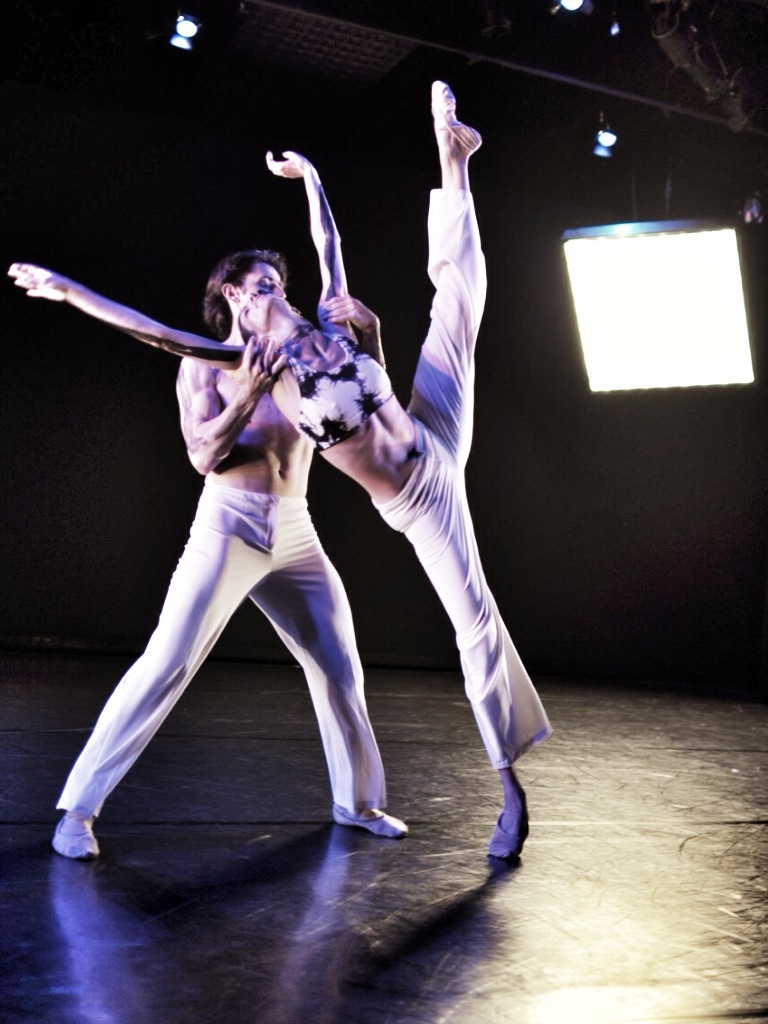Infinite Movement Ever Evolving’s recent premiere of Maurice Causey’s Grim Eye made me feel like I was in 1990s Berlin. In particular, I thought of a Depeche Mode record party I attended one December night in a smoke-filled warehouse in Kreuzberg. This is not to suggest that either iMEE or Causey are in any way old-fashioned. On the contrary, when young people in Houston want to see a ballet embodying their lifestyle and emotional concerns, it’s likely they go to see iMEE.

 While many dance critics of my generation are stuck lamenting over the demise of Balanchine and Stravinsky, I continue to focus on a more recent and equally important legacy: William Forsythe’s protégés. More and more of his former dancers are returning from Europe to present their work in America, and Causey is a striking choreographic voice among them. The simple fact that he is in Houston working with the glamorous young dancers of  iMEE is a sure indicator of the healthiness of the dance scene here. It is difficult to label Causey as an American choreographer, even if he comes from Alabama. His work and activities, from what little I know about him, are largely based in Europe and seem to be developing in terms of a more European dance aesthetic, just like that of his mentor. Â
I don’t know exactly why football players wear black stripes of greasepaint under their eyes. A friend who follows football told me that it has to do with reducing glare in the sun, and that it also gives the appearance of a second set of eyes, which might distract an opponent on the field. In either case, the same greasepaint stripes seem apt in Causey’s dance within the context of Jeremy Choate’s bright fluorescent light boxes. When the dancers eventually face upstage, they have stripes smeared on their shoulders as well, giving them the appearance of two-faced warriors.
Perhaps Causey’s choice of music by Gabriel Prokofiev (grand-son of the legendary Sergei) for Grim Eye evoked, for me, the mood of mid-90s Depeche Mode. I am always a little irritated when a choreographer does not choose to name a particular score in program notes, as was the case here, but I speculate it was in fact Prokofiev’s Concerto for Turntables and Orchestra. The music has such an insistent pulse and is so deeply layered that at times it becomes almost arrhythmic. A variety of taped sounds mingle with a symphony orchestra and are well-organized into various “chunks†or sections, which Causey acknowledges skillfully in his choreographic phrasing.
As an idea, Grim Eye is some sort of proving ground. Soloists emerge for long phrases during which the other dancers stand and watch as if judging. There are large, powerful unison sections for the ensemble that result in spectacle. A highly stylized and recurring walk often makes it seem as if the dancers are trying to step over something dangerous, like landmines or claw traps. It is certainly a ballet, depending on a versatile classically-trained body to realize a collective épaulement, or unified body direction that keeps shifting either in confrontation with, or retreat from, the viewer.
One of Choate’s light boxes flickers insistently while the other burns bright and insistent. It’s an incident that anyone who has ever worked in a crappy office building could recognize as familiarly irritating. There is an entire narrative just in the arrangement and juxtaposition of those two light boxes, as if they are incompatible but stuck-together lovers. Their “quarrel†seems to affect the movement of the group dancing underneath them.
A wood-and-string, tree-like structure with two red apples graced the stage for the other premiere on the bill, Andrea Dawn Shelley and Spencer Gavin Hering’s Superfluous, which is set to an assortment of iconic American songs from the 1950s. Though the dance began with an overt reference to Adam and Eve being expelled from paradise, the narrative continued along a different thread, perhaps inspired by the lyrics of Harry Belafonte’s rendition of Angelina:
“I’ve heard the bawdy tunes
I’ve been in honky-tonk saloons
I took my liquor by the vat
Well I stayed on call for a rousing brawl
Home was where I hung my hat.â€
Consequently, in one passage a woman performs a swooning solo while holding a big red bottle of liquor. In another, the men engage in a drinking game at an upstage bar only to mimic vomiting in pails shortly thereafter. The compelling dancer Edgar Anido tries to finish his solo while wearing one red high-heeled pump, but he seems too drunk to control the phrases. It doesn’t appear that anybody can hold his or her liquor, which is most definitely coming directly “from the vat.†It’s a desperate, fleeting world.
Compared with Prokofiev’s vast score in Grim Eye, however, the limitations of the shorter popular melodies (Patsy Cline’s Crazy, Elvis Presley’s Love Me Tender, et al.) are evident, and as a result the dance doesn’t finish so much as it wanes.
Why Do Fools Fall in Love? plays along as the women undress to their white slips, the men to their bleached white wife-beaters and knit boxers. They are an attractive, sensual group of people, but there is something perfectly sexless about the episode, as if it has been spruced up for a family audience. It’s difficult to sense whether the irony is comic, tragic, or merely situational as the lyrics roll on, “Love is a losing game, love can be ashamed.â€


